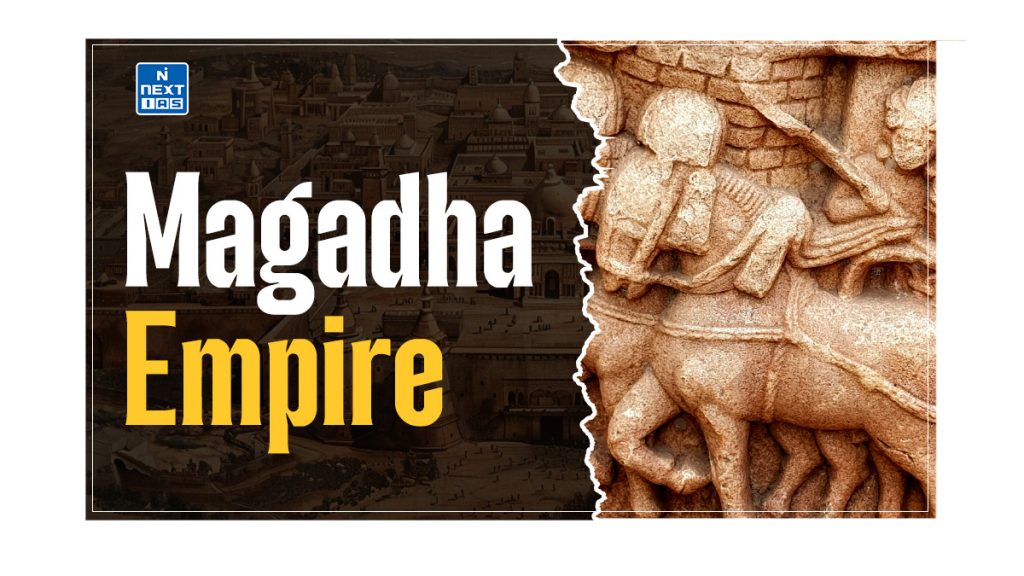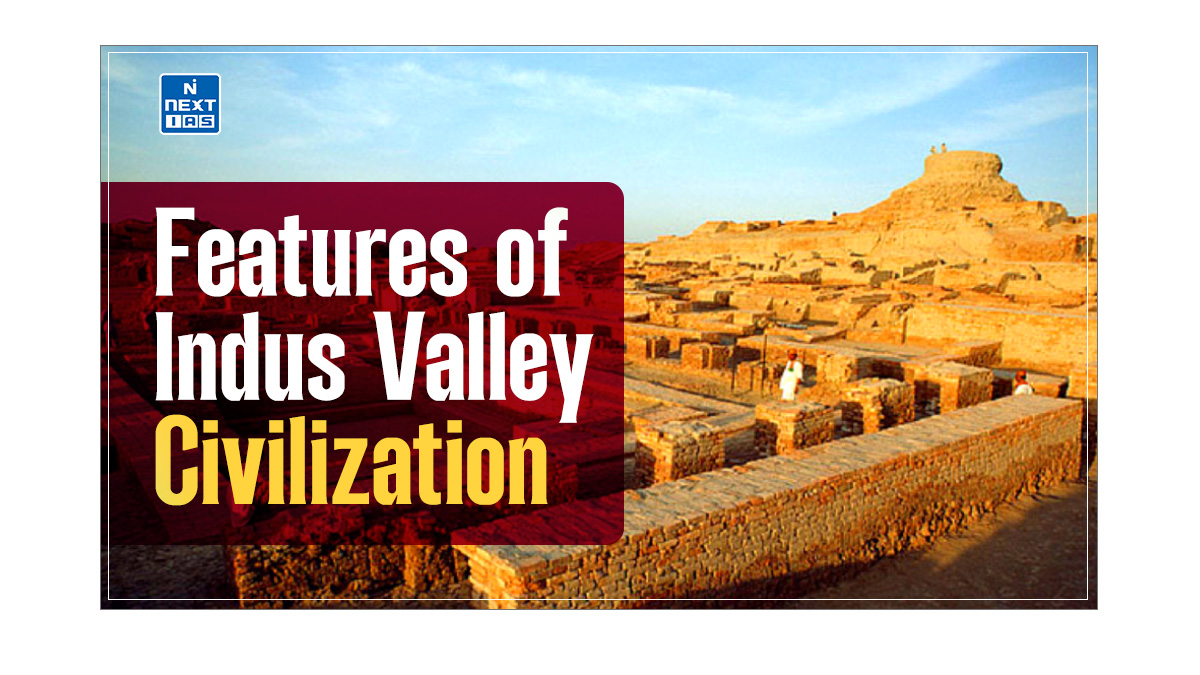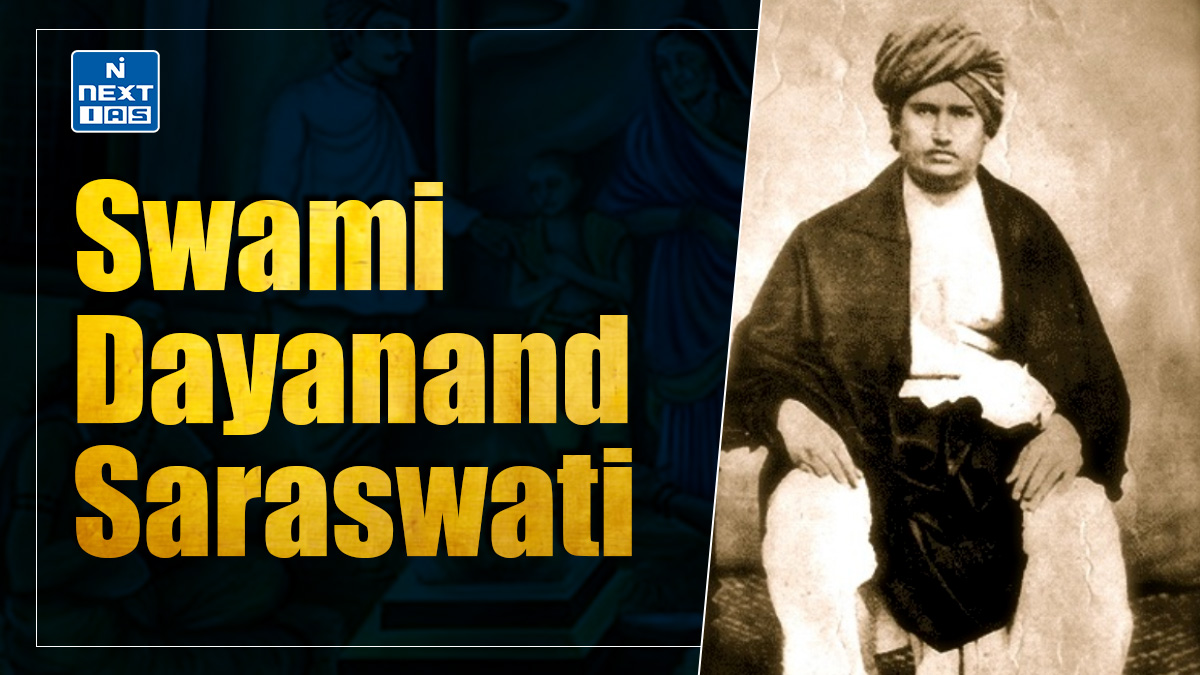
The Magadha Empire was a powerful and influential ancient Indian empire known for its strategic location and political significance. It played a crucial role in the formation of the Mauryan Empire and contributed significantly to the political and cultural development of ancient India. This article aims to study in detail the Magadha Empire, its rise and reasons for the rise, and important dynasties, including Brihadratha, Pradyota, Haryanka, Sisunaga & Nanda, and other related aspects.
About Magadha Empire
- Magadha was the most powerful of all Mahajanapadas.
- It was located in the Patna and Gaya areas of Bihar.
- To the north of Magadha, the kingdom was the Republic of Vajjis, which consisted of eight clans. The most important were the Licchavis, who had their capital at Vaishali.
- To the west of Magadha was the Kashi kingdom, with its capital at Varanasi.
- Kosala later conquered it.
- The struggle for power among these Mahajanapadas started in the sixth century. In this struggle, the kingdom of Magadha emerged victorious, which later culminated in the formation of the Magadha Empire.
Rise of Magadha Empire
- The ascendancy of several influential dynasties marked the rise of the Magadha Empire in ancient India.
- Initially, the Brihadratha Dynasty established the Magadha Empire as a significant regional power.
- Following this, the Pradyota Dynasty became prominent, further consolidating the region’s influence.
- The Haryanka Dynasty, under the leadership of Bimbisara and his son Ajatashatru, played a crucial role in expanding the territory of Magadha and strengthening its political position.
- This was succeeded by the Sisunaga Dynasty, which continued the expansion and consolidation efforts, setting the stage for the rise of the Nanda Dynasty.
- The Nandas, with their notable administrative and military prowess, ultimately transformed Magadha into one of the most powerful empires of ancient India, paving the way for the subsequent Mauryan Empire.
All the prominent dynasties of the Magadha Empire have been discussed in detail in the following section.
Brihadratha Dynasty
- Brihadratha founded the Brihadratha dynasty, the first dynasty to establish rule over the Magadha.
- The details of the Brihadratha dynasty are given in the Mahabharata and Puranas.
- According to this, he was the eldest of the five sons of Vasu, the Kuru king of Chedi, and his queen Girika. Even the Rig Veda mentions the name Brihadratha.
- The kings of this dynasty ruled for a very long period, and King Jarasandha was the most famous and influential king of the Brihadratha dynasty.
- He is also mentioned in the Mahabharata as a mighty warrior. Jarasandha was said to have succeeded by his son Sahadeva, who was killed in the Kurukshetra War of Mahabharata.
- Ripunjaya, the last of the Brihadratha dynasties, was believed to have been killed by a minister named Punika/Pulika.
- After Ripunjaya’s death, Punika placed his son, Pradyota, on the throne and founded the Pradyota Dynasty.
Pradyota Dynasty
- Punika/Pulika was the founder of the Pradyota dynasty.
- He killed his master, Ripunjaya, the last king of the Brihadratha dynasty and blessed the kingdom to his child.
- The historical findings of this dynasty are confusing and misleading at times because the Pradyotas were kings of Avanti, and their capital was Ujjain.
- However, the empire of Magadha is added to their sphere of rule.
- The mistake of including the Avanti rulers among Magadha rulers probably arose because of the sovereignty Avanti established over Magadha.
- The Puranas wrongly mention Pradyota and Bimbisara as ruling over the Magadha Empire, separated by an interval of over a hundred and fifty years.
- As we know from Buddhism, Jaina, and other Sanskrit works, they were contemporaries ruling over Avanti and Magadha, respectively.
- Regarding the prevalent religion, it is confirmed from the epical sources that Brahmanism and Buddhism were the two main religions that prevailed during the Pradyota period.
Haryanka Dynasty

- Bimbisara founded this dynasty and ruled roughly from 544 BC to 492 BC.
- He was a contemporary of Buddha. He started the policy of annexation and expansion.
- He conquered Anga and entered into a matrimonial alliance with the daughter of the king of Kosala and the sister of Prasenjit.
- This marriage was strategic as it wavered off Kosala’s hostility. The second marriage was with Chellana, the Licchavi princess (also the mother of Ajatsatru).
- The third marriage alliance was with the daughter of the Madra clan of Punjab.
- King Bimbisar’s marriage relations gave him enormous diplomatic prestige and scope to establish the Magadha Empire as the most powerful empire of its time.
- Bimbisara was succeeded by his son Ajatsatru, who is said to have killed his father (i.e. Bimbisara) for the throne.
- Ajatsatru followed a more severe and aggressive expansion policy, which brought Kashi under his influence.
- Although Ajatsatru was the son of the Licchavi princes, this did not stop him from going to war with Vaishali, which he eventually won after a long period of sixteen years.
- Thus, the Magadha Empire was enlarged by the addition of Kashi and Vaishali.
- Ajatsatru was succeeded by Udayin (460 BC—444 BC). He built forts upon the confluence of the Ganga and Son rivers at Patna.
- This was done because Patliputra (Patna) was strategically situated in the centre of the Magadha Empire of that time.
- This provided an invincible defence and ample scope for the empire’s expansion.
Sisunaga Dynasty
- Sisunaga founded the Sisunaga dynasty. Kalasoka or Kakvarnin shifted the capital to Vaishali for a brief period.
- The most prominent achievement of the Sisunagas was the destruction of Avanti’s (Ujjain) power.
- This ended the long rivalry for power between the Magadha Empire and the Avanti Empire.
- After this, Avanti was incorporated under the Magadha Empire and continued to be part of it until the collapse of Mauryan rule.
- Mahananda was the last emperor of the Sisunaga dynasty.
- He was killed by Nanda, who usurped the throne and founded the Nanda Dynasty.

Nanda Dynasty
- Mahapadma Nanda founded the Nanda dynasty around 467 BC.
- The Nandas of the Magadha Empire became the most powerful and feared rulers of that time.
- The Nandas’ might was such that even the great conqueror Alexander, who was invading Punjab and the North West Frontier then, did not dare move towards the east.
- Mahapadma Nanda was the paramount ruler of the Nanda dynasty, profusely expanding the empire and acquiring Kalinga and Kosala. He accepted the Ekarat title, the sole sovereign who destroyed all other ruling princes.
- The Nandas had acquired enormous wealth, which in turn supported the expansion and modernisation of their armies.
- It is said that they maintained a vast army consisting of an infantry of 2,00,000, a cavalry of 60,000 and 6,000 war elephants. All this required an effective and efficient tax collection system they supposedly possessed.

- One of the main reasons for the fall of the Nanda dynasty was their unpopularity among people.
- They were thought to be of low caste origin. Dhana Nanda was the eighth son of Mahapadma Nanda and he was also the last ruler of the Nanda dynasty. Chandragupta Maurya overthrew him.
Reasons for Rise of Magadha Empire
The rise of Magadha Empire to become the most powerful among all Mahajanapadas culminates in various factors.
- Advantageous Location: The region of the Magadha Empire was blessed with its geographical location. It was supplied by the nutrient-rich silts brought up by the Ganga River. Highly productive alluvial soil and well-irrigated land resulted in surplus agricultural production.
- Surplus Resources: This generated enormous revenue and food for the state, which was essential for feeding and maintaining the vast armies.
- Availability of Iron: An unhindered quantity of iron ore in the present-day Chotanagpur region of Jharkhand made it accessible and provided resources for tools and weapons.
- This was a massive advantage for the Magadha Empire, as iron was not readily available in other parts of different kingdoms.
- The manifestation of the importance of iron can be seen in the rise of Avanti (Ujjain), which also had the availability of iron used for making tools and weapons.
- This was one of the reasons why Avanti rose to be the most serious challenge and a threat to Magadha Empire.
- Strong Rulers: The rulers of the Magadha Empire were quite ambitious. Rulers like Bimbisara, Ajatsatru, and Mahapadma Nanda were excellent strategists and executioners. They employed all means to expand and strengthen their empire.
- Strategic Location of Capitals: The two capitals of the Magadha Empire, Patliputra and Rajgir, are very strategic. Five hills surrounded Rajgir, and with the level of military advancement and technology available then, it was almost unbreakable.
- Patliputra was later chosen as the capital because of its centralised location. It occupied a pivotal position for commanding communication on all sides.
- Moreover, Patliputra was situated at the confluence of the Ganga, the Gandak, and the Son. The River Saryu also joined the Ganga close to Patliputra.
- This river system allowed for quick and easy movement of traders and armies in all directions and to other kingdoms and regions.
- Also, Patliputra’s surroundings, surrounded by rivers, make it vulnerable to foreign attacks and invasions. Hence, it acted as a proper water fort (Jaldurga).
Mahajanapadas: Important Facts
| – In the 6th century B.C., northern India consisted of many independent kingdoms, some of which were monarchies and others of which were republics. – The monarchies were concentrated on the Gangetic plain, whereas the republics were scattered on the foothills of the Himalayas and in north-western India. – These republics consisted of a single tribe, such as the Shakyas, Koliyas, Licchavis and Mallas or a confederacy of tribes, such as the Vrijjs and Yadavas. – The formations of states and republics in the 6th century B.C. have often been linked to urbanisation, also referred to as second urbanisation. – Some towns grew as political and administrative centres, such as Hastinapur, Rajagriha, Shravasti, Kaushambi, Champa, and Ahichhatra. – Many others grew as markets, each catering to a variety of villages, usually located where there was an agricultural surplus that could regularly enter an exchange nexus. If the market was on a trade route, such as at Ujjain, the exchange could be extended to goods from more distant places. – Towns also grew as sacred centres where people gathered, as with Vaishali. – The Hathigumpha inscription indicates Mahapadmananda’s Kalinga victory. According to this, Nanda King took away the statue of King Jinsen and built a canal in Kalinga. – Mahapadmananda or Ugrasen was also called Servakhsatrantaka and Aparoparashurama in puranas. – Patliputra was founded by Udayin, who was the successor of Ajatshastru. He shifted the capital of the Magadh Empire from Rajgriha to Patliputra. – The 16 Mahajanapadas of the 6th century BC are described in the Buddhist text ‘Anguttar Nikaya’ and are also found in the Jain text ‘Bhagavati Sutra’. |
Conclusion
The rise of the Magadha Empire illustrates a dynamic period of political evolution and consolidation in ancient India. Each dynasty contributed uniquely to the growth and strength of Magadha, setting a precedent for future empires. From the foundational efforts of the Brihadrathas to the administrative innovations of the Nandas, the continuous development and strategic expansion under these dynasties forged a powerful empire that would influence the course of Indian history. This legacy of Magadha Empire paved the way for the Mauryan Empire and left a lasting impact on the political and cultural landscape of ancient India.
FAQs
Who was the founder of Magadha Empire?
According to ancient sources, King Brihadratha is credited with founding the Magadha Empire.
What are the 7 dynasties of Magadha?
The most prominent 7 dynasties of Magadha Empire include – Brihadratha Dynasty, Pradyota Dynasty, Haryanka Dynasty, Sisunag Dynasty, Nanda Dynasty, Maurya Dynasty, and Shunga Dynasty.
Is Magadh and Maurya Empire same?
No, Magadha and the Maurya Empire are not the same. Magadha was a region within ancient India, while the Maurya Empire was a vast empire that encompassed much of the Indian subcontinent.






